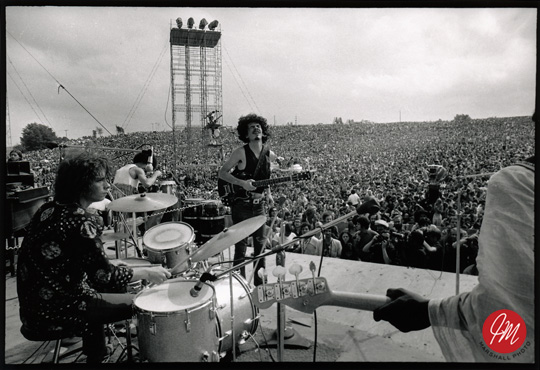Woodstock just happened: a planned event
that became an unplanned legend. Before August of 1969, few people ever
heard of this farm land outside of Bethel, New York, where Bob Dylan (who, despite pleas, didn’t perform) had a home, and which was later immortalized in the song “Woodstock” by Joni Mitchell (who also didn’t perform).
More than on the musicians, the media focused on the spectacle: a sudden outpouring of crowds, in and around the Woodstock festival, which would personify the chaotic Sixties forever as the decade neared its end. Nothing like it had ever been seen before.
The Woodstock Music & Art Fair (billed as an “An Aquarian Exposition: 3 Days of Peace & Music”) was organized by John Roberts (trust-funder), Joel Rosenman (lawyer), Artie Kornfeld (Capitol Records executive) and Michael Lang (record producer), the oldest of the four who was only 26.
The group chose a 600 acre dairy farm in Bethel, owned by Max Yasgur, in Sullivan County, New York; in fact, not in the town of Woodstock itself, in adjoining Ulster County, but 43 miles to the southwest of it.
It famously became a “free concert” only after it became obvious that the event was drawing hundreds of thousands more people than the organizers had prepared for. Tickets for the event cost US$18 in advance (approximately US$106 today calculated for buying power, and approximately US$75 today adjusted for inflation)and $24 at the gate for all three days.
Ticket sales were limited to record stores in the greater New York City area, or by mail via a Post Office Box at the Radio City Station Post Office located in Midtown Manhattan. Around 186,000 tickets were sold beforehand and organizers anticipated approximately 200,000 festival-goers would turn up. WikipediaRichie Havens opened the show on Friday, August 15, 1969 at 5:07pm; on the morning of August 17, Jimi Hendrix would close it with a 16-song set, including his famous (or, some would say, infamous) psychedelic version of The Star Spangled Banner.
However, the rock ‘n’ roll merely served to accompany the unprecedented levels of sex and drugs amongst a crowd that, before the festival had reached its midpoint on Saturday afternoon, had grown to an estimated 500,000 people.
One of the worst traffic jams in American history occurred on the New York State Thruway with miles of bumper-to-bumper traffic backed-up for over 14 hours. Many abandoned their vehicles and made their way to the concert area or drifted through the adjacent towns and villages. The locals viewed these strange visitors with a mixture of bemusement, amusement, suspicion and contempt, but never without interest.
 |
| Santana’s “Soul Sacrifice” was a show-stopper |
Less than a month after Apollo 11 had proudly landed on the Moon, and within a couple weeks of the ignominy of Senator Ted Kennedy’s Chappaquiddick incident and the insanity of the Manson killings, nearly half a million young people were, for the most part, able to assemble peacefully: a legend in and of itself; a spontaneous if temporary reaffirmation of these restless denizens of the Age of Aquarius.





No comments:
Post a Comment